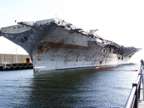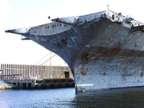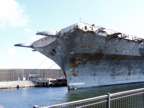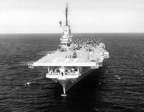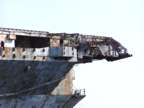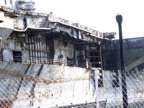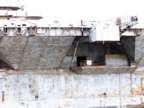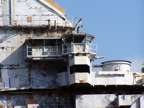USS Oriskany lies n State in Pensacola
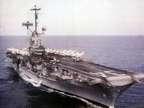 Oriskany in her heyday Courtesy cougarware.com |
This is a more fitting end for the "Mighty O" than the careless torch of the scrap yard. She now "lies in state" at the municipal pier in Pensacola Florida, a town long associated with the Navy. Pensacola is the site of the first European settlement in the US and the home of Naval Aviation.
| It is difficult for anyone and impossible for someone who was in the military during WWII, Korea or Viet Nam to walk in the shadow of this magnificent corpse without a lump in his throat! Those who served on her can almost feel the gentle vibration that was always under their feet when she was alive. You can almost hear the whuuump-bam as her hydraulic catapults (later upgraded to steam) flung a Corsair, AD, or a F8 into the air. |
| There is a thin
but constant slow procession of people walking slowly around her.
Some fascinated, some with a gentle tear, but few who don't stand
a little prouder. Most are silent, almost as people walked around
Reagan's casket, but there were some old men with blue baseball caps,
who point to a specific place: "There was where I stood watch"
– or "where my combat station was" – or "where
I catted off in my Cougar." |
The Burial
|
|
|
They are determined that
that won't happen here. The specialized plans include many small
C4 explosives along the keel. A radio signal from a boat probably
at a distance of at least ½ mile away will set them off.
Don't expect fireworks. The explosions probably won't be visible
and if everything goes right, she will take about eight hours to
slowly with great dignity lower herself right-side up where she
will, like the old men in blue caps, continue to serve her country.
|
In reverse order, from the latest back to 1942
so new items can be added at the top
05/18/2006 Sitting Pretty! Oriskany now
sits as planned facing north on the sandy bottom. First reports show she
sunk in the sand slightly deeper than hoped and is 5 to 21 feet deeper
than planned. She will be open to divers at noon today. For the whole
story, see"
The
Pensacola News Journal
05/17/2006 Oriskany's Burial at Sea
| And Kilroy Was There – Isn't
he everywhere the military is?
At 1020, 17 May 2006 Oriskany felt 22 mortal blows along her keel. She already had huge holes opened in her bow and stern to ensure that she sank upright. Hundreds of onlookers felt the rumble. She shuddered slightly then settled almost imperceptably for about 30 |
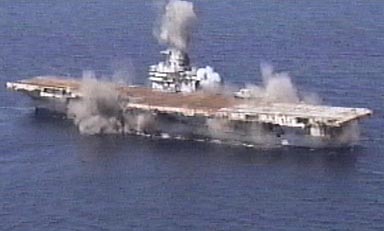 Explosions rock The "Mighty O"! US Navy Photo |
OK, OK, I was moved by the spectacle! I consider this
a memorial service and a proper burial. Click
the star for a picture Gallery
05/07/2006 Oriskany burial on schedule! Weather permitting she will be buried at sea on May 17. There will be a reception and memorial service on Saturday, May 13 at the National Museum of Naval Aviation. It is not open to the public but more than 400 ex-crew members are expected to attend. For more details see:
03/02/2006 Oriskany sinking set for May 17
For more details see
The
Pensacola News Journal
03/01/2006 "The USS Oriskany is
headed back to Pensacola in less than a week to become the world's largest
artificial reef.
The retired aircraft carrier spent hurricane season in Beamont, Texas.
On March 6th it will begin a week long tow toward Allegany Pier, NAS Pensacola for two months of prep work before it is sunk on May 17th.
Divers and fisherman are expected from all over the world for the sinking...a 2004 Florida State University study estimated that 92 million dollars a year will be pumped into the local economy.
VADM Jack Fetterman/United States Navy (Ret.); "It's gonna be a tremendous amount of impact on especially for hotels coming out and I think it really ties in with this waterfront project we're trying to put together."
In Mid-May the Oriskany will be towed 22-point-five miles southeast of Pensacola to be sunk in 212 feet of water." This quote is from WEAR TV of March 1. For details see: www.weartv.com
01/11/2006 With luck, the Oriskany will
become a fishing reef by June 1, beating the next hurricane season.
$2.8 million project now $12.73 million and counting. "With all the
money we've sunk into this thing, we probably could have built three replicas
out of clean steel. It might be funny if there weren't so much money involved."
Retired Vice Adm. Jack Fetterman, who was instrumental in luring the Oriskany to Pensacola, said he has pleaded with officials for months to "just sink the thing and be done with it."
"I don't think the Navy expected in their wildest dreams it would be this difficult," he said. "I would not like to be the program manager trying to explain to my boss how the price has become this astronomical. But I've got a certain comfort level that it will be back. They've got too much invested in it."
Read the details at: Pensacola
News Journal
12/21/05 The "final phase"
of the permitting process begins with a public hearing on January 10,
2006. The 30 day period set out for public comment ends January 19. If
all goes well, Oriskany will be returned to Pensacola for burial 22.5
miles south of Pensacola. For details see the Pensacola
News Journal
10/02/05. Oriskany rode out Rita but
costs escalate. See details in the Pensacola
News Journal
09/26/2005 I just received word that USS
Oriskany survived and is in good shape! However, she may not be returned
to Pensacola for internment if preparation not completed by January -
another hurricane season delay. Watch here for details coming soon.
09/23/2005 USS Oriskany, moved to Texas to avoid hurricanes, now faces Rita The ship is currently moored about 75 miles east of Houston, facing a dangerous hurricane of at least Category 3. The Navy has no plans to move the Oriskany out of Rita's projected path!.See the Beaumont Enterprize story for details.
5/4/2005 Oriskany's burial at sea delayed again. According to
Brett Norman at the Pensacola News Journal the Pensacola port is not safe
enough for her during the next hurricane season. So back to Texas she
goes at more expense ($1.8 million round trip.) She will be towed back
to Beaumont, Texas to wait out the next hurricane season. She will remain
there until January or until the EPA gives their long overdue approval.
Too bad Japanese Admiral Yamamoto didn't have to get their approval before
contaminating Hawaiian waters in 1941! For more details, see PensacolaNewsJournal
2/13/05
Burial Date Delayed! The burial is delayed until
after the next hurricane season. They planned on a burial in June but
the death of the scientist responsible for environmental assessment forced
a postponement. She will be prepared in a "hurricane mooring arrangement"
until after the next hurricane season.
2/13/05 TOURS now scheduled (but not aboard)
The Pensacola Historical Society is offering the "Oriskany Parking
Lot Program." At noon every Saturday a former USS Oriskany crewman,
Robert Price, will give a 25 minute lecture about the historic ship. The
tour is free and will continue until the ship's burial. Tours are conducted
in the parking lot behind Oriskany at the Port of Pensacola.
2004: Towed by ocean going tugs, she left Corpus Christi, Texas for
Pensacola, where she will undergo final preparations to be buried.
2004: Escambia County, after exhaustive selection process, was selected as site for burial.
|
2004: Towed to Corpus Christi, Texas, for cleaning and preparation as an artificial reef. 1999: Towed around the horn to Beaumont, Texas. 1997: After a prolonged effort, the contractor defaulted and Oriskany was repossessed by the Navy 1995: Sold for scrap, Vallejo, Calif. |
1989: Stricken from the Naval Vessel Registrar.
|
1976: Decommissioned in Alameda, Calif 1975-76: Oriskany makes her final cruise in the Western Pacific 1972: 150 nautical miles east
of Da Nang, South Vietnam USS ORISKANY and the USS NITRO (AE 23)
are in a minor collision during an underway replenishment. |
|
1969-1973: Oriskany conducted combat operations off Vietnam. 1968: Back to San Francisco Bay Naval Shipyard Overhaul and repairs 1967: Senator John McCain, R-Ariz (then Lt. Commander) was shot down and taken prisoner after taking off. 1966: Arrives at new home port,
Alameda, California, after a magazine fire on board kills 44 crew
members off Vietnam |
| 1966: Oriskany Suffers a major fire while operating off Vietnam. The fire starts when a crewman panics and throws a flare, which had accidentally ignited while being moved, into a storage locker located at the forward starboard corner of hangar bay one. The locker contains some 650 other flares which ignite in turn. The resulting fire takes three hours to control, kills 44, destroys or damages six aircraft, and puts the ORISKANY out of action for several months. |
1965: Oriskany's pilots of Carrier Air Wing 16 flew their first combat sorties of the Vietnam conflict on May 8, 1965.
1958-59: Angled flight deck and hurricane bow added during major renovation.
1953: A bomb dislodged from a plane after a combat mission over Korea bounces twice across the deck of the USS ORISKANY and explodes, killing two
1953: "The Bridges of Toko Ri'' filmed aboard
|
1952-53: Combat operations off Korea. 1952: Arrives at home port, San Diego. 1952: Becomes first aircraft carrier to round Cape Horn. 1950: Commissioned, New York Naval Shipyard. |
1945: Launched.
1944: Keel laid
1943: Congress authorizes construction of attack aircraft carrier USS Oriskany, CV-34.
1942: Contract awarded:
The History of the name
Oriskany, NY, a village in between Rome and Utica, NY is a small town that holds a lot of history. The name itself is derived from "Oriska," for "River of Nettles." It was named by the Oneida Indian Tribe. The Battle of Oriskany is considered the turning point of the war and the Bloodiest Battle of the Revolutionary War.
Bibliography and references for more information
The
Pensacola News Journal
Naval Air
Station Pensacola, FL, The Cradle of Naval Aviation
DEPARTMENT
OF THE NAVY -- NAVAL HISTORICAL CENTER
Oriskany Museum
and Oriskany Reunion Association
TheNational Park Service,
Links to the Past
Oriskany
Battlefield State Historic Site
Official
homepage of the USS Oriskany, CV/CVA-34.
Florida
Keys National Marine Sanctuary
Key Largo Florida Keys, The Spiegel Grove
Resolve Marine Sorry,
Link no longer there
WEAR TV
|
Visitors since
June 6, 2000 |
